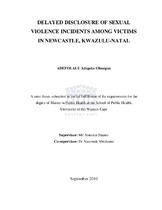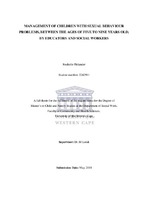| dc.contributor.advisor | Shamu, Simukai | |
| dc.contributor.advisor | Abrahams, Naeemah | |
| dc.contributor.author | Olusegun, Adefolalu Adegoke | |
| dc.contributor.other | School of Public Health | |
| dc.contributor.other | Faculty of Community and Health Sciences | |
| dc.date.accessioned | 2013-12-10T13:57:01Z | |
| dc.date.available | 2011/02/24 10:11 | |
| dc.date.available | 2011/02/24 | |
| dc.date.available | 2013-12-10T13:57:01Z | |
| dc.date.issued | 2010 | |
| dc.identifier.uri | http://hdl.handle.net/11394/2523 | |
| dc.description | Magister Public Health - MPH | en_US |
| dc.description.abstract | The aim of this study was to identify factors associated with reporting incidents of sexual violence after seventy-two hours at the sexual assault service centre in Newcastle, KwaZulu-Natal. This descriptive study was based on retrospective analysis of 534 medical records of victims of sexual violence at the Newcastle hospital between 2005 and 2009. A data collection sheet was designed to extract information from three sources namely: the victims' hospital files, J88 forms and specific hospital forms that were completed for sexual assault victims. The collected data were entered into and processed for analysis using EPI INFO statistical package. Frequencies, means and standard deviations were calculated for the data set. Test of significance was also done using the Chi-square test and presented using odds ratios with 95% CI and p-value of <0.05. The victims' age range was 2-81years (mean= 18.84, σ=13.25). Approximately 87% were female and 59.4% of the victims were aged 0-17 years. One in five victims (19.7%) was HIV positive, and most (74.4%) reported rape with vaginal penetration. Fifty-nine percent reported within 72 hours of being assaulted. The most common reason for delayed reporting (21.5%) was fear of the perpetrator. Most of the sexual assaults were committed by male (96%) and single perpetrator (90%). Nearly a third (32.4%) of the sexual violence occurred within intimate relationships and more than two-thirds (68%) knew the perpetrators. In all, 35% sustained injuries during the assault and a third (34.5%) reported the use of weapons during the assault. Nearly half of the victims (48.7%) were referred to hospital by their relatives who also accompanied them to the facility (42.1%). Of the 198 victims that were offered post-exposure prophylaxis (PEP), 87% collected the full 28-day course. | en_US |
| dc.language.iso | en | en_US |
| dc.publisher | University of the Western Cape | en_US |
| dc.subject | Sexual violence | en_US |
| dc.subject | Delayed disclosure | en_US |
| dc.subject | Rape | en_US |
| dc.subject | Victims | en_US |
| dc.subject | Sexual assault services | en_US |
| dc.subject | Gender-based violence | en_US |
| dc.subject | Health problem | en_US |
| dc.subject | Sexual rights | en_US |
| dc.subject | Sexual assault | en_US |
| dc.subject | KwaZulu-Natal | en_US |
| dc.title | Delayed disclosure of sexual violence incidents among victims in Newcastle, Kwazulu-Natal | en_US |
| dc.type | Thesis | en_US |
| dc.rights.holder | University of the Western Cape | en_US |
| dc.description.country | South Africa | |




